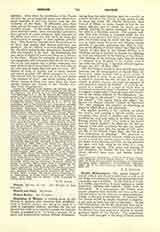

Churching of Women, a blessing given by the Church to mothers after recovery from childbirth. Only a Catholic woman who has given birth to a child in legitimate wedlock, provided she has not allowed the child to be baptized outside the Catholic Church, is entitled to it. It is not a precept, but a pious and praiseworthy custom (Rituale Romanum), dating from the early Christian ages, for a mother to present herself in the Church as soon as she is able to leave her house (St. Charles Borromeo, First Council of Milan), to render thanks to God for her happy delivery, and to obtain by means of the priestly blessing the graces necessary to bring up her child in a Christian manner. The prayers indicate that this blessing is intended solely for the benefit of the mother, and hence it is not necessary that she should bring the child with her; nevertheless, in many places the pious and edifying custom prevails of specially dedicating the child to God. For, as the Mother of Christ carried her Child to the Temple to offer Him to the Eternal Father, so a Christian mother is anxious to present her offspring to God and obtain for it the blessing of the Church. This blessing, in the ordinary form, without change or omission, is to be given to the mother, even if her child was still-born, or has died without baptism (Congr. Sac. Rit., May 19, 1896).
The churching of women is not a strictly parochial function, yet the Congregation of Sacred Rites (November 21, 1893) decided that a parish priest, if asked to give it, must do so, and if another priest is asked to perform the rite, he may do so in any church or public oratory, provided the superior of said church or oratory be notified. It must be imparted in a church or in a place in which Mass is celebrated, as the very name “churching” is intended to suggest a pilgrimage of thanksgiving to the church, and as the rubrics indicate in the expressions: “desires to come to the church”, “he conducts her into the church”, “she kneels before the altar”, etc. Hence the Second Plenary Council of Baltimore (No. 246) prohibits the practice of churching in places in which Mass is not celebrated. The mother, kneeling in the vestibule, or within the church, and carrying a lighted candle, awaits the priest, who, vested in surplice and white stole, sprinkles her with holy water in the form of a cross. Having recited Ps. xxiii, “The earth is the Lord’s and the fulness thereof”, he offers her the left extremity of the stole and leads her into the church, saying: “Enter thou into the temple of God, adore the Son of the Blessed Virgin Mary who has given thee fruitfulness of offspring.” She advances to one of the altars and kneels before it, whilst the priest, turned towards her, recites a prayer which expresses the object of the blessing, and then, having sprinkled her again with holy water in the form of a cross, dismisses her, saying: “The peace and blessing of God Almighty, the Father, the Son, and the Holy Ghost, descend upon thee, and remain forever. Amen.”
A. J. SCHULTE

